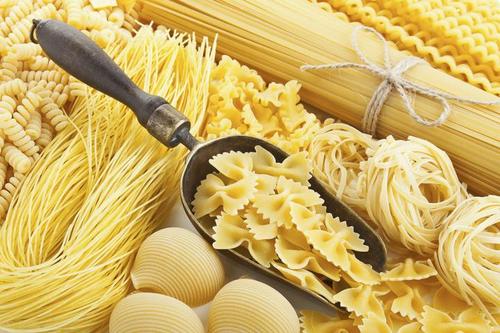Pasta - this is the general name for the hundreds of types of Italian pasta, which are the basis of thousands of dishes in sweet and savory versions. And while it was difficult to find even basic spaghetti and simple macaroni in the social market, today on the supermarket shelf one can get confused exactly which type would be most suitable for the dish one wants to make.
1. The ordinary spaghetti that everyone knows is a long and thin pasta, resembling a hardened link from an elegant man's shoe. Their shape is round, and the thickness varies from 1 mm in diameter to almost a centimeter. Spaghetti is mainly preferred for the preparation of savory dishes with sauces.
2. Linguini - under this name you will find a thin flattened pasta - it is simply spaghetti with a flat shape. If you're wondering what the difference is - you certainly won't find it in the taste. Their idea is to serve a dose of exoticism when a dish is served with them. From an aesthetic point of view, linguine is spaghetti that is easier to roll with a fork on a spoon.
3. Fettuccine - this is a flat, flattened spaghetti, thicker than linguini, which is most often sold in a twisted caterpillar shape, similar to the familiar tufi kadaif. They are suitable to replace spaghetti in all their recipes, and the important thing is to know that their thickness determines the stronger doughy taste of the dish.
4. Tagliatelle - these can be described simply as fettuccini or - understand rather wide fettuccini, which are in the same curled shape, standing up after softening the "worm" during heat treatment. Their doughy taste is even more intrusive, and to make your tagliatelle dish really juicy, you'll need a generous amount of sauce.
5. Bocatini are round straight long spaghetti with a hole in the middle. You can rely on them as the basis of a great watery dish, because the hole in the pasta is filled with sauce and turns into an extremely juicy dish.
6. Pasta penne are straight macaroni, the ends of which are beveled at an angle, and their surface is finely grooved. The length of penne varies between 3 and 6 cm, and the thickness of their opening - from 0.5 to 1 cm. They are great both for salty main dishes and salads, as well as for desserts with cheese, cream, sugar and egg-milk sauce.
7. One idea thicker than penne pasta is rigatoni. If you are an improviser and love Italian cuisine, then with rigatoni you will make some pasta dishes that are quite different from the traditional ones. It's worth a try.
8. Cannelloni are straight, smooth macaroni with a fairly large opening. Unlike other types, they are specially designed for filling. The main recipes for cannelloni are stuffed with minced meat or cheese. A method of preparing the dish with topping is also common. The cannelloni sleeve eaten on top looks a lot like lasagna.
9. Fusilli are one of the funniest macarons – they don't have a hole in the middle, but are spiral threads twisted like a negro curl. They are mainly used for salads or children's meals, because of their fun appearance. When cooked, the spirals can be stretched, and a rich filling or sauce is nestled between their ribs. Fusilli add a good vibe and are easy to poke with a fork.
10. Another type of pasta salad is farfalle. In translation, farfali means butterflies, and their name comes from the resemblance to the beautiful nasokomo. Culinaries often compare this type of pasta with a bow tie. They are small and thin and do not resemble the basic familiar Italian pasta.
11. Annelines are a paste that is mostly used for desserts. They look like cross-cut macaroni with a thickness of about 0.5 cm. Due to their small size, they are used as an additive in jelly desserts, creme-caramel, baked dessert with milk, eggs, sugar and cheese. Some parents even boil them and then add them to the milk of their toddlers.
12. Did you know that lasagna crusts are a type of pasta that is made on the basis of spaghetti? This "Italian secret", which has fascinated billions of people around the world with its divine taste and numerous varieties, is nothing more than tagliatelle rolled out in a different form. But the ways in which it is prepared differentiate lasagna significantly from its relatives.
Source: http://www.kulinarno.bg/novini/%D0%B2%D0%B8%D0%B4%D0%BE%D0%B2%D0%B5-%D0%BF%D0%B0%D1% 81%D1%82%D0%B0-%D0%B8-%D0%B8%D1%82%D0%B0%D0%BB%D0%B8%D0%B0%D0%BD%D1%81%D0% BA%D0%B8-%D1%82%D0%B5%D1%81%D1%82%D0%B5%D0%BD%D0%B8-%D0%B8%D0%B7%D0%B4%D0% B5%D0%BB%D0%B8%D1%8F-323
- Home/
- News
Types of pasta and Italian pasta
Types of pasta and Italian pasta
See the difference between spaghetti, fettuccine, tagliatelle, rigatoni, bocatini, cannelloni, annellini, macaroni, farfalla, penne, fusilli and linguini. ....
- Newsletter

